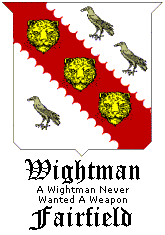Reading
On these pages you will find the best in speculative fiction books, with brief reviews. The reviews are all positive: if I don't like it, I don't promote it. I have also included pages with research resources, which others with like interests may explore.
As a convenience to visitors, links are included for all books to Amazon.com, and you may add directly to your shopping cart from here.
Contemporary Classics Non-genre Medieval Resources Movies
Resources for the aspiring medievalist. See our sections on Literature, Warfare, and Daily Life.
Warfare |
|
|
Medieval Warfare: A History by Maurice Keen An overview of campaigning, composition of troops, and the evolution of technology. |
The Knight in Medieval England, 1000-1400 by Peter Coss The development of the knight from Old English "boy" into an order of nobility, from a military aristocracy to an honorific title. Knight's fee and scutage, and the economics of plate mail. |
|
Castles: Their Construction and History by Sidney Toy No other book I have seen gives a better picture of fortified buildings, from Ancient Sumer to the invention of the cannon. Filled with floor plans and photographs, and discussions of the many historical and theoretical means of bringing them down and keeping them up. |
English Weapons & Warfare: 449-1660 by A.V.B. Norman and Don Pottinger A good overview, with basic history for those who want to know such questions as "when did cannon first appear on the battlefield?" (1326) There are a few inaccuracies in terms of the social forces driving technological change, but it still makes a solid reference. |
|
Medieval Swordsmanship: Illustrated Methods and Techniques by John Clements An excellent beginning for the novice wanting to learn the sophisticated martial arts of the west. Covers basic stance, grip, and all the classic wards, as well as giving guidelines for training. Warning: if you learned to fight in the Society of Creative Anachronism, this is different. The fact that a medieval enemy could grappel and pull you down means that the SCA stance must be changed, which changes the fundamental principles of striking blows. Clements covers sword and shield, long-sword, and archeological evidence of medieval practices. |
The Secrets of German Medieval Swordsmanship: Sigmund Ringneck's Commentaries on Master Leichtenauer, Christian Henry Tobler, ed. A translation of a genuine 14th century manual for the use of the longsword. Tobler gives his own interpretations and hints, which is useful to the 21st century student, and liberally illustrates it with clear photographs. The work is not as well laid out for the novice--its medieval authors assumed some basic understanding (which Tobler helps fill in)--but it covers far more ground than Clement. Winding about a bind, changing through, following after, the Crooked Strike, the Winking Strike, and the Strike of Wrath. |
Daily Life |
|
|
Life in a Medieval Village by Frances and Joseph Gies Marriage in and out of churches; justice in the manor, village, and clerical courts; food, ale, rents, fines, and more fines. A wide-ranging overview of how much it sucked to be a serf. |
Pagan Religions of the Ancient British Isles by Ronald Hutton An investigation of the archeological record of pre-Christian British-Isle beliefs. Hutton discusses grave goods, mounds, sacrificial burials, standing stones, and carvings, as well as Roman records, and from this evidence debunks silly theories and casts hints at the truth. |
|
Arthur's Britain: History and Archaeology, Ad 367-634 by Leslie Alcock An investigation of the archeological record of Arthurian legend, from the most ancient reference in Easter Tables to alleged Arthurian tombs. A thorough and scholarly report. |
|
|
Online, may we recommend VikingAnswerLady.com, an excellent and authoritative source on Norse culture, including everything from legends about the salt in the sea, the Norse view of homosexuality, and recipes for Viking meals. LiteratureFor books by and about J.R.R. Tolkien, please visit the Numenor Resource page. |
|
|
Beowulf: A New Verse Translation by Seamus Heaney The great Anglo-Saxon epic, the original "High Fantasy." Filled with kennings, boasting, swords, treasure, and gruesome battles. Perhaps the most readable of ancient English lays. |
Norse tales of dragon-slaying, warfare, jealousy, heroism, and revenge. Stephan Grundy retold this for his recent Rhinegold, Mallory may have been inspired by it when he had Excalibur trapped in a stone, C. S. Lewis may have been inspired by this dragon for the one in Voyage of the Dawn Treader, and this is the very sort of tale Tolkien complained of not having in English, the complaints that lead him to write. |
|
One of the great Icelandic sagas. If you didn't get enough mayhem from the Volsungs, try the Elder tales. Multiple journeys to the underworld in search of magic tools. The mill that could grind out peace makes an appearance, along with many gods. |
The Arthurian Chronicles: Wace and Layamon [Lazhamon]. Includes the most ancient Arthurian tale written in (Old) English, as well as an older, French version (both translated by Eugene Mason). Includes the adventures of Arthur's predecessors beyond Uther: Aurelius, Constance, Vortiger, and more. Many Saxish heathens are deprived of life-day. |
Top |
|
Design by Web Wight.
Contents are ©1999-2001 by Brian Wightman, all rights reserved.
